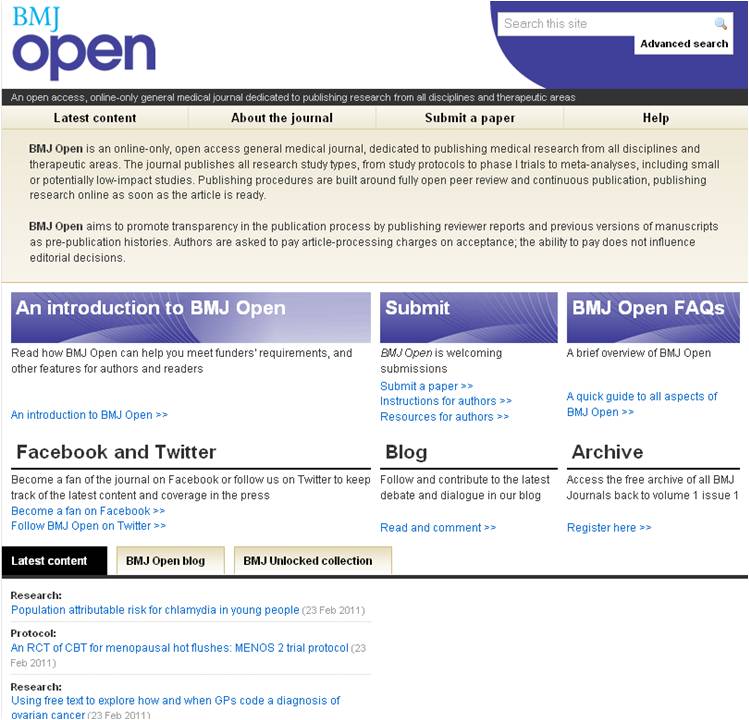This week saw the launch of BMJ Open, a new online journal from the BMJ Group. BMJ Open is fully open access and exists to publish research from across all medical disciplines. It offers authors the option to have their work peer reviewed thoroughly for appropriate methods and transparent reporting, but without judgement being applied about novelty or importance. If after peer review the article is deemed worthy of publication, it will be published and deposited in PubMed Central.

The open access is supported by levying an article processing charge (APC) of £1200 for any accepted article (although discounts and waivers are available).
Innovative features
Among BMJ Open’s firsts for BMJ Group journals is use of the Disqus commenting and rating system, as explained in a previous post. As of April we will be publishing article-level metrics to show article usage.
The journal is also the first in the group to publish reviewers’ comments for accepted articles. Reviewers’ comments and the previous versions of the article that those comments apply to are published alongside the final copy-edited and typeset HTML and PDF versions. This gives credit to reviewers, many of whom play a considerable role in improving papers, as well as providing a more transparent publication process.

Data sharing
How to store and share raw data is one of the hottest topics in publishing at the moment. We are currently working with data curation and publication experts to provide authors with a simple and efficient way of storing their data and linking to it from their article. In particular we are working with the Dryad UK project, part of the UK JISC’s Managing Research Data programme. Watch this space for further developments.
Sharing raw data helps bring the complete research record in to the open. Another way of doing this is through publication of research protocols. We encourage authors to submit their original research protocol with their article, but we will also be publishing protocols themselves, and two were published this week. We will also consider ‘pre-protocols’; innovative study designs yet to receive funding/approval.
To encourage this joined-up approach, authors can publish ‘two articles for the price of one’, by receiving a 50% discount on the APC when the protocol is published and a further 50% discount if they publish the resulting research in BMJ Open.
More information
Trish Groves, editor-in-chief of BMJ Open and deputy editor of the BMJ, explains more about the aims and scope of the journal and its place in the BMJ Group’s open access offerings here; the journal’s first published papers are here and you can submit here.
Naturally the journal has a presence in the blogosphere, on Twitter and on Facebook, so you can let us know what you think, comment on articles and spread the word about the journal or papers that catch your eye.


 From the end of last year, BMJ blogs became fully open access using the creative commons license. They have always been free to access, and it is likely that most of our readers will not immediately notice any change, but there is a subtle difference.
From the end of last year, BMJ blogs became fully open access using the creative commons license. They have always been free to access, and it is likely that most of our readers will not immediately notice any change, but there is a subtle difference. highlighted elsewhere and bought to the attention of more people. It is also in keeping with the “social” aspect of blogging. We have found that using Twitter and Facebook to promote our blogs has had a huge impact on traffic to the site. Users like to share links and comment on blogs, and this encourages others to take a look at the site as well.
highlighted elsewhere and bought to the attention of more people. It is also in keeping with the “social” aspect of blogging. We have found that using Twitter and Facebook to promote our blogs has had a huge impact on traffic to the site. Users like to share links and comment on blogs, and this encourages others to take a look at the site as well.